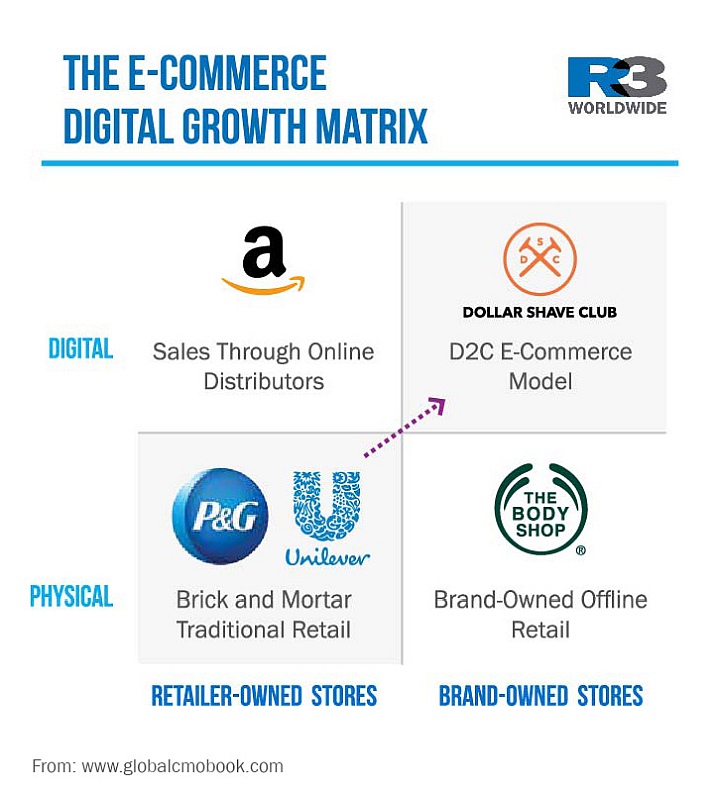By Greg Paull, Co-Founder & Principal, R3 Worldwide
Set off and transformed by companies like Amazon, e-commerce now not only expect
CPG brands to get their piece of pie; it is also forcing other industries to respond to the current consumers’ need for experiences. This, of course, includes intimate services and instant gratification.
Indeed, companies can no longer simply approach e-commerce as a separate entity within their organisations. The business model itself must be shifted and e-commerce needs to be made an integral part of marketing and sales strategies. This is the only to differentiate a company of the future. Not acting fast enough has its consequences. As is, since 2015, 57 retail brands have declared bankruptcy.
e-Commerce Digital Growth Matrix
As per industry expectations, the imperative, is not as straightforward. There are many challenges facing today’s global brands as they integrate e-commerce into their business strategies. For some, the process can be harder as a result of jumping on the bandwagon a little too late. Even worse, these businesses have no clear understanding how best to identify and align with e-commerce models.
What type of challenges each brand faces, and how they face them; of course, this all depends on their sector and where they fall within the E-Commerce Digital Growth Matrix.

The following points below details how the E-Commerce Digital Growth Matrix works:
Physical Retailer & Brand Owned Stores
The bottom left and right quadrants are where big companies including CPG giants – P&G, Nestlé, and Unilever – are currently making around 95% of their revenue. In this model, not only do the companies gather little to no consumer data from a purchase, they also have no control over the consumer experience.
Digital Retailer-Owned Stores
The top left quadrant, which includes retailers like Amazon, Taobao, and Flipkart, is where online distribution giants have made their home. For many brands, what started out as a symbiotic relationship to drive sales might be working against them now. They are essentially paying online retailers to deliver aggregate data on their own consumers; at the same time, online retailers are leveraging that data to take market share away from the very brands they are carrying.
Digital Brand-Owned Stores
Moving into the top right section of the matrix are the companies that have embraced the
direct-to-consumer (D2C) model with full control over their own data and customer journey,
embodied here by Unilever’s Dollar Shave Club. This is the ideal online setup for many
organizations. However, shifting to the D2C model does not come without its own
challenges; particularly for CPGs in the food and beverage sector that must factor complicated supply chain logistics.
In the case that D2C doesn’t make sense for an organization, brands should seek to deepen
their relationships with more established online platforms, like Amazon, Taobao, and Lazada. These platforms are constantly innovating and brands should keep their packaging, products, and even their supply chain fluidly in line with those of the retailer.
Local & Global Partnerships
Closer partnerships with these platforms also help brands keep in touch with consumer
habits in wildly different markets; specifically, where identifying the true needs of large numbers of people in a foreign country is a challenge. In order to make e-commerce work, brands need to make sure they are interfacing with the consumer at all the right touch points. This is to ensure that the larger digital strategy and e-commerce strategy are the same thing.
According to YH Lee, CMO of Samsung, the biggest change to the customer journey is that customers rely on technology more than ever. As is, there are more brands vying for customer attention, engagement, and loyalty. “This means it is more difficult to accurately predict the customer’s buying decision process,” she said. “Groups with demographically similar identities can still show a large variation in purchase patterns; though it also depends on their individual lifestyle and values.”
For example, single millennial women who actively share information online and invest in self-care are less sensitive to price; instead, they are more active in online shopping through mobile than other single consumers. “Facing these realities, marketers must deliver messages that are not only customised to the right
audiences in the right places; they also need to maintain an authentic human and emotional
connection,” Lee continued.
One Seamless Experience Across Many Places
Purchasing has become an increasingly complex behaviour across diversified platforms; yet consumers still think of shopping as one experience regardless of channel. Brands need to
embrace that mindset treating the consumer journey as one smooth process and not break it down into the traditional silos.
In order to do this successfully, brands need to do two things – firstly, properly leverage their consumer data; secondly, develop an omni-channel strategy. They also need to ensure that an e-commerce strategy stays true to the brand voice.
Text by: Victor Yap
MARKETING Magazine is not responsible for the content of external sites.










